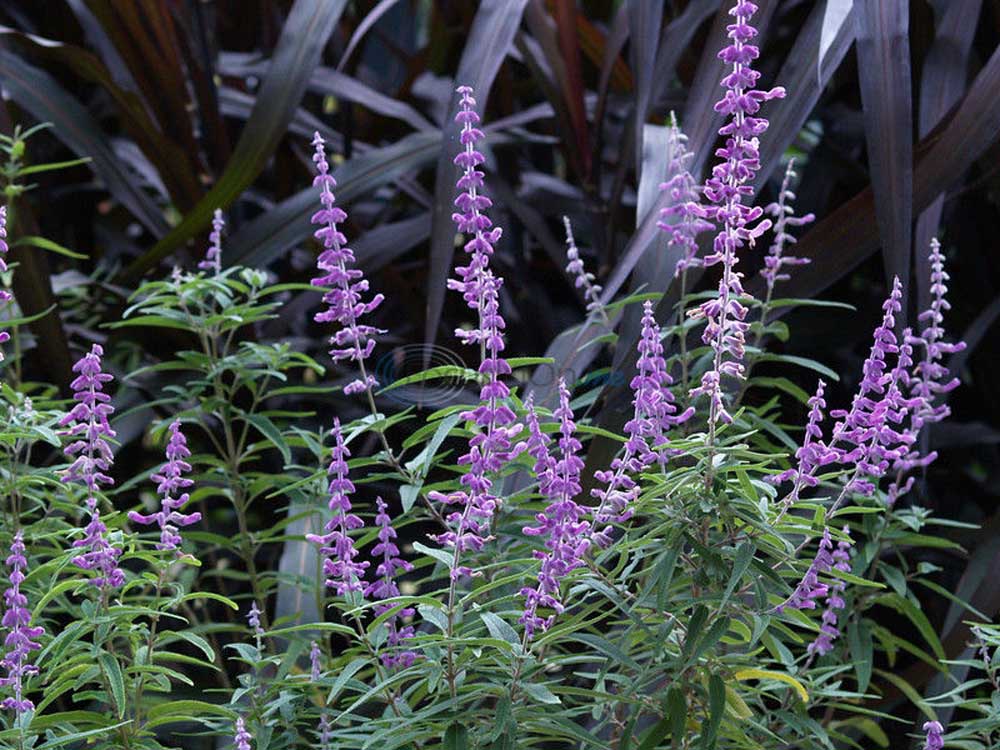Fall plants ready to show their colors as summer fades
Published 11:00 pm Wednesday, September 11, 2013

- Courtesy Mexican Bush Sage, a fall blooming salvia, is shown against the purple foliage of Napier grass.
As summer gives way to fall, many garden plants we have been enjoying all summer begin to fade. Growth slows, leaves begin to tatter and summer annuals and perennials tend to look pretty ragged as cooler weather sets in.
But not all plants are programmed for hot weather. Some wait patiently all year to put on a show in the fall, keeping our gardens pretty and interesting. Others may give a final burst of color, invigorated by milder and moister growing conditions. Here are a few favorites to keep your garden a pretty picture in the fall.
Firespike (Odontonema strictum) is a tropical-looking perennial that I once thought was not hardy here, but it has come back faithfully in my garden for more than 15 years. It is perfect for shady locations, with large, glossy, dark green leaves that emerge once the weather turns hot. In late summer and early fall, an abundance of long spikes bearing brilliant red, tubular flower appear. This colorful perennial is a favorite of hummingbirds, and blooms during the fall migration, providing an important source of food. It will keep blooming right up to first freeze. It tolerates shade so well that it can be brought inside for a foliage plant over the winter.
Firebush (Hamelia patens) is a great option for both summer and fall color. This Texas Superstar blooms very well into late summer and early fall and, as the weather starts to cool, the leaves take on a nice burgundy hue, which is quite attractive. The more sun, the better it grows and shows.
One of my favorite salvias is the Mexican Bush Sage (Salvia leucantha). It is attractive even when not in bloom, with soft, gray-green leaves, making a graceful mound about 4 or 5 feet tall. In late summer and early fall, they produce rich purple and white flowers spikes on the ends of the shoots. There are several named varieties, some having all purple flowers, and one dwarf, called “Santa Barbara,” growing only 3 feet tall. There are several other salvias that mainly are fall bloomers.
Mexican mint marigold (Tagetes lucida), also called Spanish tarragon and yerba anise, is one of my favorite herbs. I just like the way it smells. It is a true marigold, but doesn’t bloom until late fall. Blooming is triggered by the shorter days and longer nights of fall, but sometimes is delayed so long that the bright yellow flowers come out very late in the season. But the foliage has a delightful aroma all season long and tastes like tarragon or anise. Full sun for this fragrant herb.
After the first soaking rain in late August or September, out pops delightful red rain lilies called Oxblood lilies (Rhodophiala bifida), and a little later, red spider lilies (Lycoris). They do well in both full sun and under deciduous trees. The best way to acquire them is through a friend or neighbor, or at the Fall Conference and Plants & More sale held every fall in Tyler (Oct. 12 this year).
Don’t forget roses! Many varieties will put on a spurt of growth once extremely hot weather moderates, ending in October with a flourish of flowers. The nice thing about fall rose blooms is that they tend to last longer because of the milder weather. Many rose growers lightly prune back in late August or early September to encourage the flush of growth. Be sure to visit the Tyler Rose Garden in about a month in mid-October to see what fall rose blooms are all about!
Another shrub that we don’t usually think about having fall blooms is the azalea. We all enjoy the profuse spring display of blooms, but there are a few varieties that will usually throw a scattering of blooms again in the fall. One of my favorites is called Watchet, a compact variety with large, single pink blooms. A newer group of azaleas have been bred with the specific goal of creating reliable reblooming varieties called the Encore series. The Ina Brundrett Azalea Garden located between Wise Auditorium and Jenkins Hall on the Tyler Junior College Campus is a great place to observe a large collection of almost all the different Encore varieties.
Finally, we can’t forget the lovely Sasanqua camellia. This attractive shrub with dark, glossy green leaves produces an abundance of showy flowers in late fall and early winter. This great landscape shrub deserves a place in every East Texas landscape.
Keith Hansen is Smith County horticulturist with the Texas A&M AgriLife Extension Service. His web page is http://EastTexasGardening.tamu.edu. His blog is http://agrilife.org/etg.






